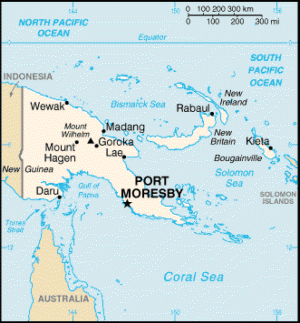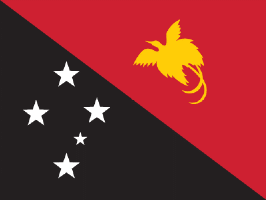| Independent State of Papua New Guinea Location eastern half of the
island of New Guinea, as well as a chain of islands that
extends over 1,000 miles (1,600 kilometers)
Bordered By Indonesia
Area 178,656 sq mi (462,840 sq km)
Highest Point Mount Wilhelm; 14,793 ft
(4,509 m)
Lowest Point Pacific coast; sea level
Natural Resources gold, copper, silver,
natural gas, timber, oil, fisheries

Nationality Papua New
Guinean
Population (July 2013 est) 6,431,902
Largest Cities Port Moresby
Ethnic Groups Melanesian, Papuan,
Negrito, Micronesian, Polynesian
Religions Roman Catholic, Lutheran,
Presbyterian/Methodist/London Missionary Society;
Anglican, Evangelical Alliance, Seventh-Day Adventist
Languages Melanesian Pidgin, English
Capital Port Moresby
Form of Government constitutional
parliamentary democracy
Current Constitution Adopted September
16, 1975
Chief of State Queen Elizabeth II
(since February 6, 1952)
Head of Government Prime Minister Peter
Paire O'Neill (since August 2, 2011)
Cabinet National Executive Council, appointed by
Governor General on recommendation of Prime Minister
Legislature unicameral National Parliament
Judiciary Supreme Court
Local Administration 20 provinces
Currency Kina
Per Capita Income $2,800
Industries copra crushing, palm oil processing,
plywood production, wood chip production, gold mining,
silver mining, copper mining, crude oil production,
petroleum refining, construction, tourism
Agricultural Products coffee, cocoa, copra, palm
kernels, tea, sugar, rubber, sweet potatoes, fruit,
vegetables, vanilla; shell fish, poultry, pork
Export Commodities oil, gold, copper ore, logs,
palm oil, coffee, cocoa, crayfish, prawns
Import Commodities machinery and transport
equipment, manufactured goods, food, fuels, chemicals
Independence from
Australian-administered UN Trusteeship Achieved
September 16, 1975
National Holiday Independence Day,
September 16
Flag divided diagonally from upper
hoist-side corner; upper triangle is red with a soaring
yellow bird of paradise centered; lower triangle in black
with five, white, five-pointed stars of the Southern
Cross constellation centered -- red, black, and
yellow are traditional colors of Papua New Guinea; the
bird of paradise, endemic to the island of New Guinea, is
an emblem of regional tribal culture and represents the
emergence of Papua New Guinea as a nation; the Southern
Cross, visible in the night sky, symbolizes Papua New
Guinea's connection with Australia and several other
countries in the South Pacific

SEE ALSO
Indonesia
Queen Elizabeth II
Questions or comments about this
page?
|
 SKC Films Library
SKC Films Library
